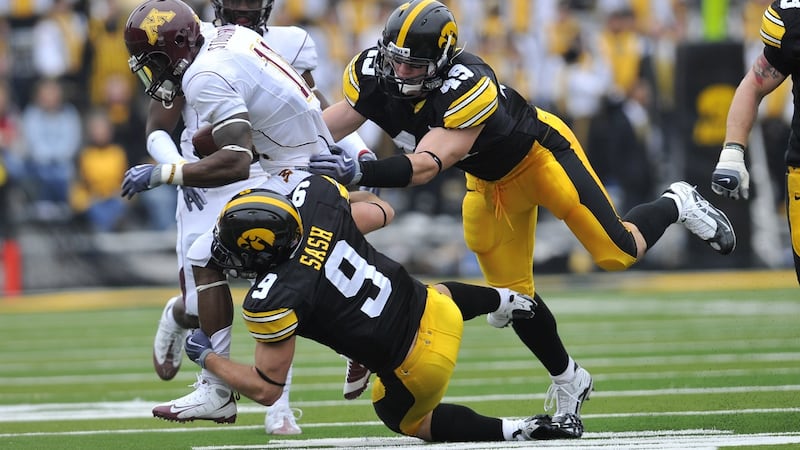Dr Ann McKee, a neuropathologist, has examined the brains of 202 deceased American football players. A broad survey of her findings was published on Tuesday in The Journal of the American Medical Association.
Of the 202 players, 111 of them played in the NFL and 110 of those were found to have chronic traumatic encephalopathy, or CTE, the degenerative disease believed to be caused by repeated blows to the head. CTE causes myriad symptoms, including memory loss, confusion, depression and dementia. The problems can arise years after the blows to the head have stopped.
The brains studied are from players who died as young as 23 and as old as 89. And they are from every position on the field: quarterbacks, running backs and linebackers, and even a place-kicker and a punter. They are from players you have never heard of and players, like Ken Stabler, who are enshrined in the Hall of Fame.
Some of the brains cannot be publicly identified, per the families’ wishes. One brain studied is from Ronnie Caveness, a linebacker for the Houston Oilers and Kansas City Chiefs. In college, he helped the Arkansas Razorbacks go undefeated in 1964. One of his teammates was Jerry Jones, now the owner of the Dallas Cowboys. Jones has rejected the belief that there is a link between football and CTE.
Another is the brain of Ollie Matson, who played 14 seasons in the NFL after winning two medals on the track at the 1952 Helsinki Olympic Games. He died in 2011 at age 80 after being mostly bedridden with dementia, his nephew told The Associated Press, adding that Matson had not spoken in four years.

McKee, chief of neuropathology at the VA Boston Healthcare System and director of the CTE Center at Boston University, has amassed the largest CTE brain bank in the world. But the brains of some other players found to have the disease like Junior Seau, Mike Webster and Andre Waters were examined elsewhere.
The set of players posthumously tested by McKee is far from a random sample of NFL retirees. “There’s a tremendous selection bias,” she has cautioned, noting that many families have donated brains specifically because the former player showed symptoms of CTE.
But 110 positives remain significant scientific evidence of an NFL player’s risk of developing CTE, which can be diagnosed only after death. About 1,300 former players have died since the BU group began examining brains. So even if every one of the other 1,200 players had tested negative, which even the heartiest sceptics would agree could not possibly be the case, the minimum CTE prevalence would be close to nine per cent, vastly higher than in the general population.
The NFL’s top health and safety official has acknowledged a link between football and CTE, and the league has begun to steer children away from playing the sport in its regular form, encouraging safer tackling methods and promoting flag football.

Linemen
Linemen make up the largest share, by far, of those tested by McKee, partly because nearly half of the 22 players on the field are offensive and defensive linemen. But that may not be the entire reason. Linemen knock heads on most plays, and those who study brain trauma say the accumulation of seemingly benign, nonviolent blows, rather than head-jarring concussions alone, probably causes CTE.
Data compiled by researchers at Stanford University showed that one college offensive lineman suffered 62 of these hits in a single game. Each one came with an average force on the player’s head equivalent to what you would see if he had driven his car into a brick wall at 30 mph.
Quarterbacks
Quarterbacks, the stars and most highly paid players in the league, are now provided more protection against hits to the head than other players. But that has hardly eliminated concussions and other blows to their heads. The quarterbacks still hit their heads hard on the turf when they are sacked, or take head-jarring hits when they leave the pocket to run.

The rules that provide more protection have only recently been established. They were not in place when Ken Stabler was leading the Oakland Raiders of the 1970s. Before Stabler died, at 69, of colon cancer in July 2015, he had requested that his brain be examined to see why his condition had been progressively slipping. McKee found that he had a “moderately severe” case of CTE. The lesions were widespread, she said.
Linebackers
The brains of the 13 linebackers in McKee’s study do not include the most high-profile of them all, Junior Seau. Seau, 43, whose brain was examined by the National Institutes of Health, killed himself with a gunshot to his chest in May 2012. Suicide is not uncommon among players who suffer the effects of CTE, but McKee and other researchers caution that no correlation between the two has been firmly established.
Linebackers, like linemen, suffer many subconcussive blows to the head, the ones that show no immediate symptoms but can have a cumulative effect over time. McKee has said that linebackers who play in the league for 10 years could receive upward of 15,000 of these subconcussive hits.
Defensive backs
Tyler Sash was found dead of an accidental overdose of pain medications on September 8th, 2015. He was 27. Sash had played safety for the New York Giants on their 2011 Super Bowl team after playing the position in college at Iowa. The Giants released him in 2013 after he suffered what was believed to be his fifth concussion.
“Those concussions are the ones we definitely know about,” his older brother Josh said. “If you’ve played football, you know there are often other incidents.” Despite Sash’s young age, his family requested that his brain be examined for CTE because he was showing uncharacteristic signs of confusion, memory loss and fits of anger.

Their suspicions were confirmed. McKee said at the time that: “Even though he was only 27, he played 16 years of football, and we’re finding over and over that it’s the duration of exposure to football that gives you a high risk for CTE. Certainly, 16 years is a high exposure.”
McKee found the disease at a level similar to that found in Seau’s brain, and it was in the region of the brain that is consistent with the symptoms he was exhibiting. Sash’s mother, Barnetta Sash, said: “Now it makes sense. The part of the brain that controls impulses, decision-making and reasoning was damaged badly.”
The only one who tested negative
The family of the only NFL player without CTE in McKee’s study did not authorise her to publicly identify him.
The complete study
In addition to the 111 brains from those who played in the NFL, researchers also examined brains from the Canadian Football League, semiprofessional players, college players and high school players. Of the 202 brains studied, 87 per cent were found to have CTE. The study found that the high school players had mild cases, while college and professional players showed more severe effects. But even those with mild cases exhibited cognitive, mood and behavioral symptoms.
There is still a lot to learn about CTE. Who gets it, who doesn’t, and why? Can anything be done to stop the degeneration once it begins? How many blows to the head, and at what levels, must occur for CTE to take hold? “It is no longer debatable whether or not there is a problem in football; there is a problem,” McKee said.
(New York Times service)


















